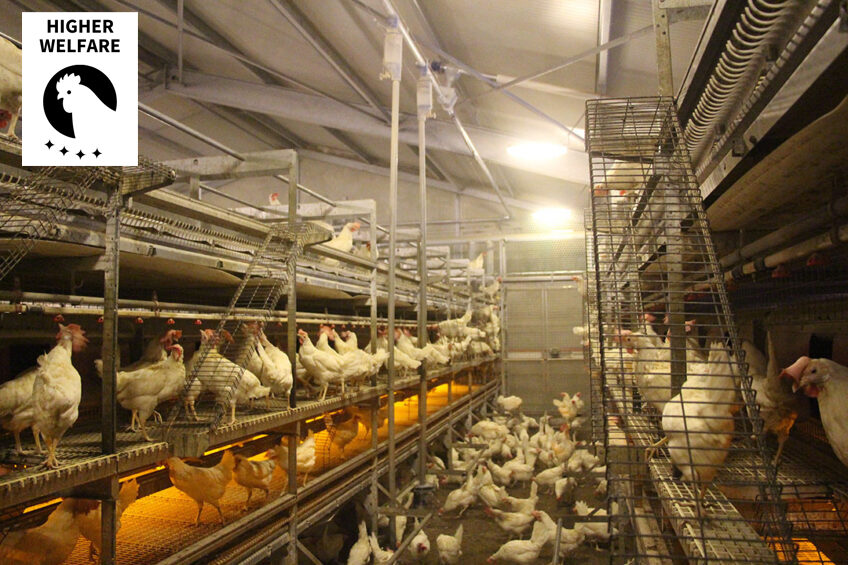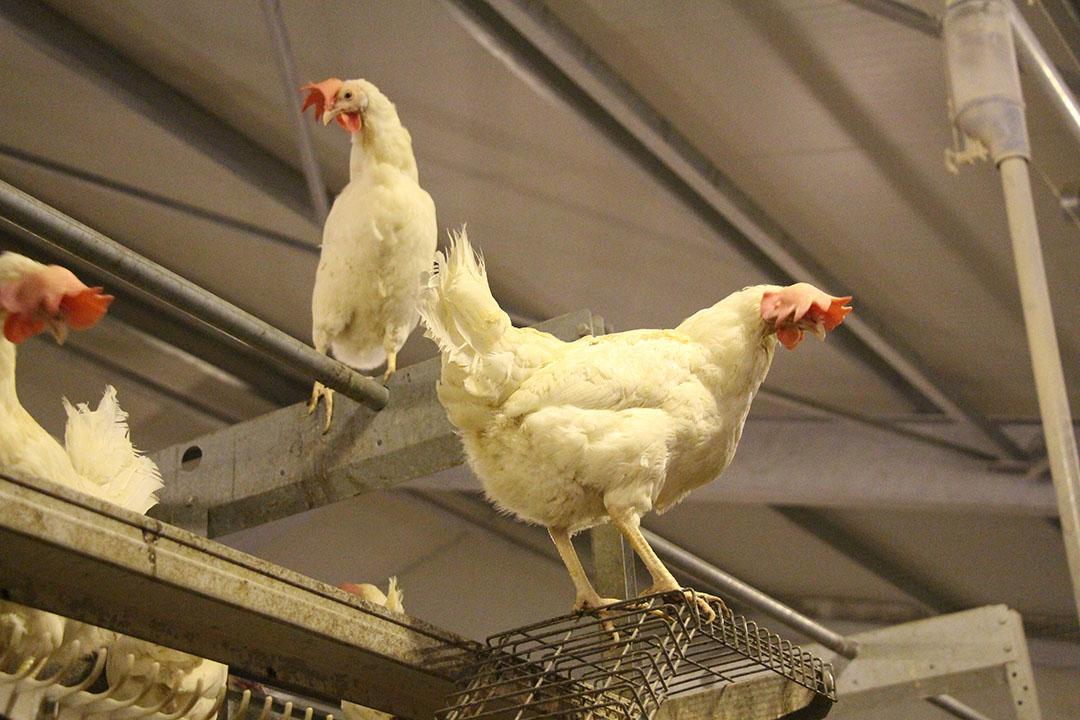Welfare doesn’t come automatically with a switch to aviary systems

Switching to higher welfare egg production encompasses more than just ripping out cages and installing an aviary system. According to poultry vet Marc Heijmans a different system has different challenges and requires good stockmanship and careful management to prevent the onset of new welfare issues.
Since the traditional battery cage was banned in 2012, layer farmers in the Netherlands gained a lot of experience with alternative housing systems. Although ‘enriched cages’, as they were termed, were still allowed at that time, most farmers switched to aviary systems early on. Veterinarian Marc Heijmans of veterinary consortium Poultry Vets, knows that the decision to introduce higher welfare housing systems will have consequences for laying hen farmers worldwide. “New welfare problems lie in wait, the laying hen sector will have to take measures on various fronts to prevent these.”
Heijmans says that the battery cage remains the most efficient and environmentally-friendly system for producing protein but it is not an animal-friendly system. “And in more and more countries around the world you see that society no longer accepts that. Battery cages are already banned in the EU and there is also increasing discussion about battery cages in eastern Europe (outside the EU) and the United States.” Heijmans notes that especially in regions of the world that are becoming increasingly prosperous, such as eastern Europe, Asia and China, people are demanding better welfare for the animal products they consume. In a country like the United States, there has always been prosperity but animal welfare was of secondary importance. However, that is changing. As the use of little or no antibiotics is already an item in broiler production, plus society at large also wants to see battery cages phased out.
Different management system
So you see more and more producers switching from battery cages to aviary systems. However, this can also have negative implications for animal welfare if management is not adjusted accordingly. Heijmans: “For example, when using aviary systems, the rearing period of the laying hens must match perfectly with the system and management of the laying hen farmer that the hens go to. Otherwise keel bone damage can occur, for example. But even if the hens have been well trained by the rearing farm on the correct rearing system, there may still be places in the aviary system where the hen encounters difficulties”. Rearing birds in cages and then moving them into an aviary system is a recipe for disaster, in his view.

In addition, the Dutch vet says, with aviary systems you have to pay more attention to the hen’s behaviour. The risk of pecking or even cannibalism is relatively high. How the hens move through the system is also important. “In this respect there is a big difference between white and brown hens. We initially thought that white hens and aviary systems would be more difficult to combine than brown hens in an aviary system, but it is actually the other way around. White hens move relatively easily through these types of systems.” As a result, the Poultry Vets vet generally sees fewer floor eggs at farms with white hens than at layer operations with brown hens in their aviary system. The reason for this is because white hens move more easily towards the laying nests. Water training during the rearing period is crucial for brown pullets, he says, to ensure that laying hens learn to move more quickly and smoothly through the system.
Types of rearing systems
Heijmans believes that the various Nivo Varia systems that are on the market are the best for teaching hens to move easily through aviary systems. “It is important with these systems that you can winch everything up (feed, water and platforms). You also have Nivo Varia systems where you work with ‘folding platforms’, as they are termed, but then you are less flexible when it comes to winching up feed, water and platforms. It is more of a fixed system. There are also rearing systems with row aviaries. I see that Dutch laying hen farmers have a preference for pullets from those types of systems. The advantage of hens from these systems is that they move about easily in their aviary system and the cost per animal place is less because you can keep more pullets per square metre of ground space.”

Aviary systems in Europe have been adapted (sometimes considerably) in recent years based on practical experience. Especially with brown hens, say Heijmans. Sometimes the system is adapted with the addition of footbridges, for example, so that the hens can more easily go up and move through the system. In aviary rearing systems extra water lines are also added above winchable platforms in the litter area between aviary systems. Heijmans: “By installing extra water lines, you force the hens to get out of the system and search for drinking water elsewhere. The disadvantage is that sometimes the uniformity of the flock is reduced as a result”. Updating aviary systems to make them even more hen-friendly is a development that will only continue, the vet believes. “Big Dutchman, for example, has developed a new system, the Filia aviary system, where you can winch the drinking water lines in the aviary system to a higher level.”
If you look at the differences between white and brown hens in terms of aviary systems then it might be useful to choose a certain hen, you might think. But then market forces and culture come into play, says Heijmans. “You have cultures that prefer white eggs more and cultures that prefer brown eggs more. And this can also differ per country or region. For example, in the central Netherlands I see a preference for brown eggs, in the south of the country more white eggs are produced. In Germany too, you have regions that have a preference sometimes for white and sometimes for brown eggs.”
More risk of diseases
Another disadvantage of laying hens in aviary systems is that the animals have contact with manure. Heijmans: “This simply means you have a greater risk of bacterial or parasitic diseases, among other things.” Furthermore, an aviary system has a lot of ironwork with nooks and crannies where red mites can hide perfectly. That is why the Q-perch system from Vencomatic has been introduced in Europe. These are perches with an electrical wire mounted on the inside. If the hens sit at the top of the system at night which means, of course, that there must be sufficient space and enough Q-perch perches, says Heijmans, the red mite cannot reach the hen due to the electrical current in the wire. The Dutch veterinarian states that another disadvantage of the disappearance of the battery cage is that poultry diseases from the 1960s have re-appeared in Europe. Heijmans: “For example blackhead, erysipelas, pasteurella (bacteria), coryza and capillaria infections”.

In addition to changing the husbandry system itself, some European countries, such as the Scandinavian countries, Germany, Austria, Switzerland and the Netherlands, are also taking other measures to improve the welfare of the hen. Like ending beak trimming. However, this can also lead to well-being problems. The worst forms of which are pecking and cannibalism. The Dutch vet indicates that you therefore have to take measures on various fronts to prevent this. “For example, thicker drinking nipples that give more water and have fewer hens per drinking nipple. Or another possibility is to start working with Plasson drinkers, open water or cups.” Plus, the ration is very important for hens with an intact beak. The structure of the feed is crucial, says Heijmans. “There should not be too much difference between finer and coarser parts, otherwise they will selectively absorb feed and then they will not get enough of certain minerals and vitamins. This can cause behavioural changes and reduce plumage.” Finally, it is important to have distraction material in the barn, such as pecking blocks or alfalfa bales.
Better Chicken Commitment
Heijmans observes that many producers in the world look at how things work out in practice when it comes to improving bird welfare. “Many states in the United States and many European countries, too. You can even see that the US is following the EU in some areas when it comes to these kinds of welfare matters. Of course, as far as the broiler sector is concerned, in the English-speaking countries and the EU there is now the Better Chicken Commitment (BCC).” The BCC has a six point policy to improve the welfare of broilers by 2024. As of June 2020, approximately 180 food companies worldwide had already agreed to this commitment, including KFC, Burger King, Subway, Chipotle, Denny’s, Nestlé and Compass Group. Heijmans: “The BCC will probably have an impact on the laying hen sector, too, ensuring that welfare-enhancing measures gain broader attention”.
Support breeding companies
Finally, Heijmans believes that the negative consequences of the switch from battery cages to aviary systems will be overcome. Through good management practices and via breeding programmes. The two largest players in the world, Hendrix Genetics and EW Group GmbH, are fully engaged in this. Heijmans: “They no longer select only on the basis of technical performance and robust hens, but also for animal behaviour. I have noticed brown hens becoming calmer in recent years. That has advantages but also disadvantages. If brown hens drum too much and move too little, you will get more floor eggs.” He continues: “And so with all these management, feeding, housing layout and breeding measures, we are working towards a farming system for laying hens that is interesting, both financially and economically, and one which offers the best welfare for the laying hens themselves.”
Join 31,000+ subscribers
Subscribe to our newsletter to stay updated about all the need-to-know content in the poultry sector, three times a week. Beheer
Beheer











 WP Admin
WP Admin  Bewerk bericht
Bewerk bericht